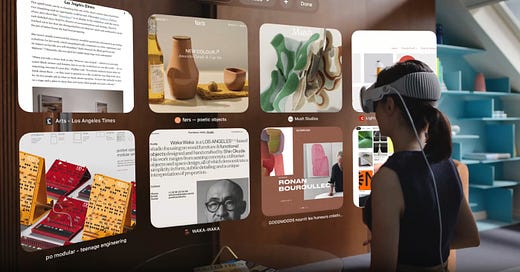Envisioning Education's Future: Apple Vision Pro and the Evolving Classroom Landscape
Innovation and Technology Need to Prove Their Value; Let's Start Theorizing What We Mean by Value
Apple’s Vision Pro: An Educational Revolution?
Source: CNET, “Apple’s Pro Vision”
Since the new year, Big Tech has unveiled numerous impressive products, with and without AI features, exciting the educational sector. The most publicized among these is Apple's Vision Pro Goggles, celebrated for their potential to transform educational environments by boosting student engagement, optimizing workflows for future encounters with AI, and shifting the classroom concept from a traditional physical space to an innovative virtual one.
Following the launch of Apple Pro Vision, various stakeholders including educators, researchers, and writers have evaluated the device, identifying numerous shortcomings. This discussion will touch upon prevalent technical problems, but aims to extend beyond to a wider critique.
We must contemplate what elements and dynamics we wish to introduce into our learning environments. Specifically, how does a device like Apple Pro Vision reshape the dynamics between students and teachers? Additionally, we will explore its potential to redefine the broader educational landscape.
Vision’s Pro Education Promise
For this article, I consulted ChatGPT-4 for information on Apple Vision Pro, fully aware that its latest update was before the product's release. Consequently, the information I expected to receive would primarily be a synthesis of Apple's promotional materials and press releases from recent years. What GPT-4 provided were idealized educational outcomes of Pro Vision:
“The Apple Vision Pro is a conceptual product designed to enhance education with AR technology, offering:
Augmented Reality Integration: Immersive experiences overlaying digital information onto the real world.
Customizable Learning Modules: Tailored content for various learning styles and subjects.
Interactive Collaboration: Real-time collaboration features for students and teachers, suitable for both physical and remote environments.
Enhanced Student Engagement: Gamified learning experiences to increase attention and retention.
Streamlined Workflow Integration: Compatibility with existing educational tools to simplify tasks and classroom management.
Data-Driven Insights: Analytics to help educators customize teaching strategies.
Aimed at revolutionizing education, the Apple Vision Pro focuses on making learning more interactive, personalized, and broadly accessible.”
Apple Vision Pro: Reality Check
This is Apple Vision's Pro dream. What is the reality?
Source: Midjourney, “This Kid Approves”
In terms of technological specifications, Vision Pro claims to surpass other AR/VR devices on the market, although this superiority comes at a significant cost.
Apple Vision Pro is Apple's premium entry into the virtual reality market, priced at $3,499. It represents a significant leap in VR technology, operating on VisionOS and powered by the M2 processor, mirroring the high performance found in Apple's Mac series. The hardware is equipped with an extensive setup including 12 cameras, six microphones, and five sensors like LiDAR, offering an immersive and interactive user experience.
Innovative features include the R1 chip, designed to process multi-modal sensor data, enhancing device interactions and environmental understanding. Pro Vision sets itself apart with its low latency of 12 milliseconds, reducing motion sickness and enhancing comfort.
Noteworthy is its Eyesight Technology, enabling users to see through the VR environment, ensuring natural interaction and awareness. Control through gestures and eye movements eliminates the need for traditional controllers, streamlining user engagement.
Additionally, the device introduces unique capabilities like capturing spatial memories with a 3D camera and offering a new level of personalization in video calls by showing the user's full face.
The integration of AR/MR content, combined with Apple's digital crown for adjusting immersion levels, and compatibility with a vast range of iOS apps, solidifies Vision Pro’s place in both the Apple ecosystem and the broader VR landscape.
Source: Midjourney, “This Kid Does not Approve”
At the same time, Apple Vision Pro has several issues that repeatedly come up in reviews, leading many buyers to return the product after a few days of use.
The primary issue is the product's considerable weight, marking a significant departure from Apple's hallmark sleek and appealing design. For the device to effectively enhance user workflows or entertainment experiences, it must be comfortable to wear for extended periods, ideally two hours or more. However, the current model causes many users to experience debilitating headaches, nausea, or deep red indentations on their foreheads after just thirty minutes of use.
The second concern is battery life. At present, the Vision Pro’s battery sustains only 2 hours of use, which is problematic since consumers primarily value it as an entertainment device. Limited battery capacity prevents users from watching a full movie on a single charge, particularly if they have already used the device for other purposes prior to loading up a video. While first-generation products typically face limitations, this particular shortfall significantly disrupts the alignment between the device's intended high-impact use case and the actual user experience.
The third issue concerns the Vision Pro’s prohibitive cost, which casts it as a luxury beyond the reach of the average consumer, drastically curtailing its chances for broad adoption and isolating it to an elite demographic. This high pricing is particularly problematic for educational institutions, which might consider incorporating this technology into their classrooms but find it financially infeasible.
Is the Promised Revolution Good for Our Students?
In the emerging landscape of educational technology, the advent of devices like Apple's Vision Pro stirs a complex blend of anticipation and skepticism. Amidst the burgeoning hype, we must scrutinize whether such innovations genuinely herald a revolution beneficial for our students. The current iteration of Apple Vision Pro, despite its grand promises, falls short in transforming the educational sector.
Yet, the speculative future of these products continues to ignite debates on the potential metamorphosis of classrooms into realms where digital and physical realms interlace seamlessly, broadening the horizons of learning beyond conventional spatial and temporal limits. This vision tantalizes with prospects of more intimate virtual interactions, yet it prompts a crucial introspection: Is such a drastic overhaul what we desire for our educational ecosystems?
Emerging Divergence; Significant Reservations
Herein lies the crux of a growing divergence among educators, myself included. We harbor significant reservations about the efficacy and appropriateness of converting traditional learning spaces into immersive, multimodal environments. These digital bastions, though rich in connectivity and data, may not align with the educational essence required to foster deep, critical thinking essential for navigating the intricate tapestry of the 21st and 22nd centuries.
Individualized + Humanized = Socially Engaged Instruction
Source: Midjourney, “The Primacy of Human Connection”
Influencing my perspective is the insightful work of Dan Meyers, a highly respected math instructor and educational consultant whose insights have profoundly shaped my understanding of effective teaching strategies. Over recent years, the educational landscape has shifted, gravitating towards highly personalized and data-driven approaches.
Such methodologies have undeniably catalyzed student development, particularly in tailoring learning experiences to individual needs. However, the allure of advanced AI systems proposes a significant paradigm shift. The trend suggests a pivot from established whole-class instruction to a model heavily reliant on AI-enhanced, individualized tutorials aimed at mitigating the educational disparities exacerbated by the COVID pandemic.
Innovation and Technology Need to Prove Their Value
Yet, in this rush towards technological integration, exemplified by the promotion of platforms like Apple Vision Pro, I perceive a misalignment with educational values. Proponents argue that such devices could bridge the gap between physical presence and virtual engagement, fostering interconnectedness across diverse learning environments.
However, initial experiences paint a contrasting reality. Users, particularly students, report feelings of disconnection, ensnared in the device's captivating embrace, which, paradoxically, severs ties with the tangible world. Far from the promised ease of toggling between realities, the immersive nature of such technology poses barriers, engendering cognitive strain and physical disorientation.
Moreover, the anticipation that this new wave of gadgets would enable educators to trace a tangible data path, crafting responsive and dynamic curricula, has yet to materialize. The harvested data, while abundant, often mirrors the impersonal, quantitatively skewed output familiar to conventional computing systems.
Source: Midjourney, “In Search of the Treasure Beneath the Surface”
Beyond the surface, this discussion transcends technological critique, venturing into the philosophical realm of educational tools and their inherent agency. As we integrate novel instruments into our pedagogical practices, we must remain vigilant to their unpredictable impacts on classroom dynamics.
The rush towards innovation, while driven by noble intentions, necessitates a pause, a reflective moment to ponder the true nature and consequences of introducing such potent fields of agency into learning environments. The educational sphere stands at a crossroads, challenged to discern between genuine enhancement and mere novelty, ensuring that the technological tools we adopt serve not as ends in themselves but as means to enrich the foundational principles of education.
Nick Potkalitsky, Ph.D.
Author’s Note: A more detailed version of this post was published at
‘s AI Supremacy on April 4. I would like to extend my heartfelt thanks to Michael for his ongoing support of my writing and mission!Check out some of my favorite Substacks:
Riccardo Vocca’s The Intelligent Friend: An intriguing examination of the diverse ways AI is transforming our lives and the world around us
Suzi’s When Life Gives You AI: An cutting-edge exploration of the intersection among computer science, neuroscience, and philosophy
Alejandro Piad Morffis’s Mostly Harmless Ideas: Unmatched investigations into coding, machine learning, computational theory, and practical AI applications
Michael Woudenberg’s Polymathic Being: Polymathic wisdom brought to you every Sunday morning with your first cup of coffee
Nat’s The AI Observer: A fascinating investigation into the emergence of higher-order reasoning in advanced AI systems, complemented by amazing coding experiments
Michael Spencer’s AI Supremacy: The most comprehensive and current analysis of AI news and trends, featuring numerous intriguing guest posts
Daniel Bashir’s The Gradient Podcast: The top interviews with leading AI experts, researchers, developers, and linguists.
Daniel Nest’s Why Try AI?: The most amazing updates on AI tools and techniques










Great read, Nick!
To be honest, it never even crossed my mind that the Apple Vision Pro is / could be billed as an education-enhancing device. I always saw it as a high-end toy for individual users, not a tool to be used in the classroom where social interactions tend to be encouraged.
But this just shows that I'm perhaps stuck in the old ways - there's certainly the potential of remote collaboration, interactive educational games that require groupwork to solve, etc. But I guess for that to become reality, the price would have to come down dramatically, all the tech issues you've outlined need to be ironed out, and it'll probably a pretty huge mindset change within educational institutions.